Sarah Gilbert embarks on a special safari to see Kenya’s endangered species by air.
Click here to download and save as a PDF.
There wasn’t much left of the zebra by the time we arrived, just the unforgettable sound of teeth crunching on bone. Ten lion cubs circled the carcass, heads down, bottoms bobbing, grizzling and growling as they tugged at the last few morsels, while two adult females lounged in the shade with full bellies.
Kenya’s Masai Mara – the northern extension of Tanzania’s Serengeti, a seemingly endless, undulating savannah renowned for the great spectacle of the wildebeest migration with predators in hot pursuit – was the first stop on Scenic Air Safaris’ Endangered Species Flying Safari.
High flyers
It was no ordinary safari. We were exploring some of the country’s most fascinating national parks from the luxury of a private plane, staying at first-rate lodges and putting the focus firmly on frontline conservation efforts with unrivalled access to key conservationists.
And the company’s Cessna Grand Caravan was no ordinary bush plane, fitted with just eight fully rotating – and reclining – leather seats and large, panoramic windows to frame the stunning landscapes, all in the company of a pilot guide and a Kenya Wildlife Services guide.
“We were exploring some of the country’s most fascinating national parks from the luxury of a private plane, staying at first-rate lodges.”
We were lucky enough to spot about 30 lions on the day-long game drive. But in the past 20 years, their numbers have dropped dramatically, with only an estimated 20,000 lions left in Africa.
Over a bush breakfast, ‘lion man’ David Mascall, the former curator of an orphaned-lion programme in Nairobi, who’s spent 30 years in the Mara, explained that the main threat to lions is humans.
“Livestock is hugely important to the pastoralist Maasai communities that surround the Mara, both economically and socially, and where bush meets grazing land, there are losses on both sides – lions kill livestock and villagers kill lions in retaliation. Engaging their support is vital to conservation success.”
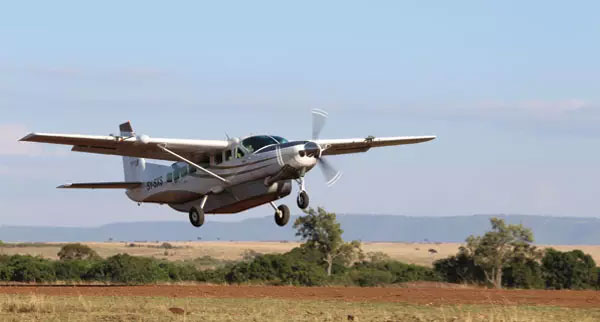
Race for survival
Joining us was Dr Elena Chelysheva, a passionate Russian zoologist with more than 30 years’ experience with captive and wild cheetah. The Maasai call her ‘mama duma’ – ‘mother of cheetahs’ – and as head of the Mara-Meru Cheetah Project, she’s out in the field every day.
It’s estimated that there are only about 7,000 of the world’s fastest land mammal left worldwide – and 65 of them are in the Mara. We soon came across the ‘five musketeers’, a coalition of young male cheetahs sprawled on a termite mound surveying their terrain.
“There are no long, bone-jangling road transfers or hanging around at airstrips, making it ideal for time-poor travellers.”
“Cheetahs face a complex range of threats, including habitat loss, prey depletion, hunting, poaching and human-wildlife conflict,” explained Elena. “They’re in a race for survival but our aim is to secure their habitats through a mix of scientific research, community outreach and education.”
It’s undoubtedly a high-end safari option – although the price includes everything – but there are no long, bone-jangling road transfers or hanging around at airstrips, making it ideal for time-poor travellers, multigenerational families or groups of friends celebrating a special occasion, even honeymooners.
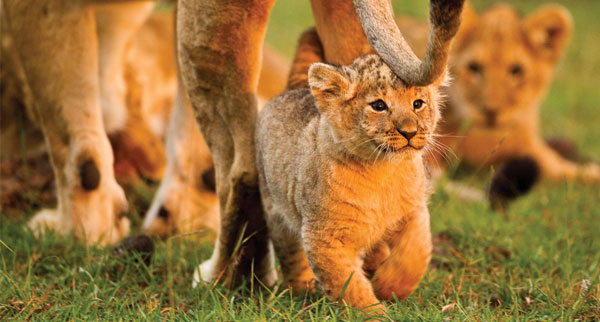
Aerial adventure
Leaving the savannah behind, we took a spectacular flight over the jagged peaks of the Great Rift Valley, and the aerial views of Kenya’s dramatic landscapes made it extra-memorable.
One day we could be skimming over jewel-coloured lakes as hundreds of vivid pink flamingos took flight, or looking down into one of the world’s largest calderas; the next we’d be following the snaking contours of a river, spying on wallowing hippos and elephants splashing around in the shallows.
“As they got down to a very public mating session, the rest of the herd circled them, enormous ears flapping all trumpeting loudly with excitement.”
Back on terra firma, alpha elephant Jager had seen off the competition and was making a beeline for a young female on heat. As they got down to a very public mating session, the rest of the herd circled them, enormous ears flapping, all trumpeting loudly with excitement.
This joyous spectacle was a stunning finale to our morning in Samburu National Reserve in northern Kenya. We’d already seen a fuzzy-haired, week-old calf, small enough to stand under its mother’s stomach to feed, two naughty teenagers engaged in a play fight, and a testosterone-fuelled male in musth that came a little too close for comfort.
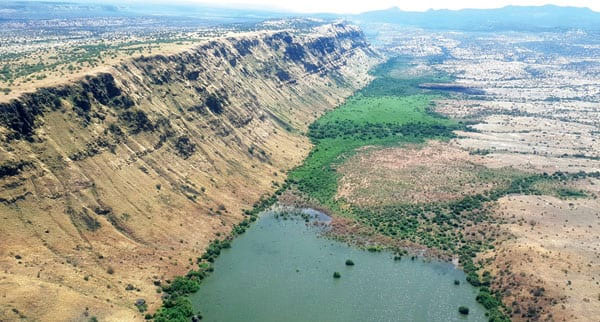
We were in Samburu to meet Saba Douglas-Hamilton and Frank Pope of Save the Elephants (STE). At their long-running project, they work closely with the local communities, as well as explaining to visitors the level of ivory poaching and what they are doing to combat it.
STE is also a pioneer in tracking, designing and testing the first-ever elephant collars. With the help of state-of-the-art technology, the organisation can map the routes of dozens of elephants, gaining insights into their habits and just how far they will travel in search of food and safety.
“They work closely with the local communities, as well as explaining to visitors the level of ivory poaching and what they are doing to combat it.”
Tourism is also playing its part. “Tourism is an economic driver to protect the elephants,” said Frank. “When we create employment here, we show people the benefit of conservation, and create elephant ambassadors at the same time.”
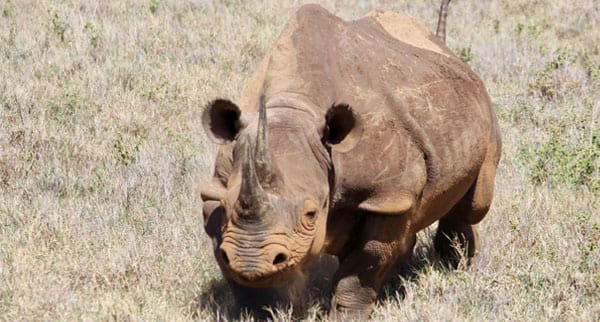
Community conservation
Poaching has decimated Africa’s rhino population but the highly successful Rhino Conservation Programme at the pioneering Lewa Wildlife Conservancy in central Kenya currently protects 87 critically endangered black and 79 white rhino.
“Rhinos have distinct personalities. They’re passionate, sensitive and very intelligent,” said rhino scientist Ian Lemaiyon, as we watched three, tank-sized white rhinos hoovering up grass.
“We haven’t lost a rhino since 2013 but protecting and nurturing them takes up to 50% of our annual budget,” he explained. Along with donations, tourism provides valuable income, as do rhino naming and adoption schemes.
“Today it’s a model for successful conservation, supporting neighbouring communities with progressive farming initiatives, education and healthcare.”
Security is key and Lewa’s operations centre is manned 24 hours a day, with rhino rangers, military-style anti-poaching units and close cooperation with local communities, which are the first line of defence against poaching.
Lewa began life as a cattle ranch; today it’s a model for successful conservation, supporting neighbouring communities with progressive farming initiatives, education and healthcare, as well as protecting the endangered species that roam among its forests of yellow-barked fever trees, marshland and granite peaks. These include the endangered Grévy’s zebra, which is stockier than the more common plains zebra. Lewa is home to 14% of east Africa’s remaining wild population.
In just over a week, we’d not only travelled in grand style – with dazzling wildlife encounters matched by equally stunning flights – but we’d also discovered an enormous amount about Kenya’s wildlife and the myriad threats it faces, from knowledgeable and engaging guides and wildlife experts.
There’s no one-size-fits-all solution, but with community involvement and the dedication and passion of the experts that I met, there is certainly hope.
Ask the expert
“Reteti is as much about people as elephants. The idea came out of meetings with the Samburu to raise awareness of the benefits that a healthy elephant population could bring: employment, education and security. Elephant calves often fall into the ‘singing wells’ that the Samburu hand-dig to give water to their livestock, and can become separated from the herd. Now the Namunyak Community has set aside land for the sanctuary, where community members raise and ‘re-wild’ the elephants until they can reunite with their herd. They’re extremely proud to have rescued 40 elephants since September 2016.”
Katie Rowe, founder of community-run Reteti Elephant Sanctuary in Namunyak Conservancy, northern Kenya.
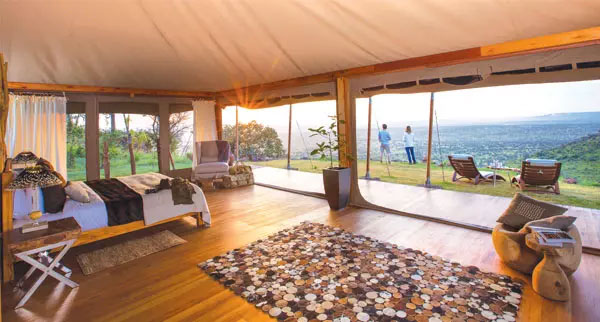
Sample product
Knighton Reeve offers a nine-day Endangered Species Safari from £8,495 per person, based on a group of six passengers sharing the aircraft, or £9,295 for a group of four. The price includes flights from London, private flights within Kenya, access to experts, full-board accommodation, game drives and park fees. The accommodation includes Asilia’s Encounter Mara, Mara Naboisho Conservancy; Loisaba Tented Camp, Loisaba Conservancy; Elephant Watch Camp, Samburu National Reserve; Lewa Safari Camp, Lewa Wildlife Conservancy; National Geographic Lodge Sarara Camp, Namunyak Wildlife Conservancy; and OneFortyEight, Nairobi.
knightonreeve.co.uk
Read more
Exploring Madagascar’s unique flora and fauna on a road trip
Visit Samburu village on an excursion from Lodo Springs, Kenya
The best winter honeymoon destinations




